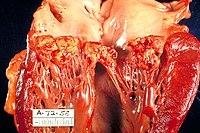
Photo from wikipedia
Introduction Intracardiac abscess complicates both native (NV-IE) and prosthetic valve infective endocarditis (PV-IE). Antibiotics alone rarely achieve source control, and if left untreated abscesses are usually fatal. Uncomplicated abscesses affecting… Click to show full abstract
Introduction Intracardiac abscess complicates both native (NV-IE) and prosthetic valve infective endocarditis (PV-IE). Antibiotics alone rarely achieve source control, and if left untreated abscesses are usually fatal. Uncomplicated abscesses affecting the aortic valve can be treated with aortic valve replacement (AVR) with or without patching of the abscess cavity. With more extensive tissue destruction aortic root replacement (ARR) may be required. The optimal surgical approach is controversial, ARR using homograft valve conduits are reported to have lower re-infection rates and have been favoured in most cases of abscess affecting the aortic root. Aims We aimed to describe the characteristics, surgical technique chosen, complications and outcomes for patients with intracardiac abscess presenting over more than a decade. Methods Consecutive patients assessed between 01 January 2005 and 31 December 2017 were identified from a prospectively collected database used for service evaluation of IE care. We required patients to have Duke definite IE with evidence of intracardiac abscess on imaging or found at operation. We recorded patient demographics, affected structures, microbiology, complications of IE, operative details and outcomes. Results There were 68 episodes of intracardiac abscess occurring in 59 patients, of whom 44 (75%) were male, 10 (17%) were persons who inject drugs (PWID) and the mean age was 55.7 +/- 16.3 years. Affected structures were primarily the aortic (55) and mitral (17) valves. Thirty-one (53%) had NV-IE and 28 (47%) had PV-IE. Multiple aortic cusps were involved in 68%. Bacterial pathogens were mainly Streptococcus (26) and Staphylococcus (18) species, which were associated with NV-IE (p=0.009) and PV-IE (p=0.005) respectively. The most common complications were heart failure (44), heart block (12) and systemic emboli including stroke. Forty-four (75%) patients underwent surgery, 28 had AVR and 14 ARR. The 30-day surgical mortality rate was 10 (23%) and associated with infection with S. aureus (p=0.006) and higher Euroscore II (p=0.03). No other operative factors were associated with survival including the timing of surgery and whether AVR or ARR was undertaken. During long-term follow up there were 9 episodes of re-infection which did not differ between AVR and ARR. The all-cause mortality in operated patients was 34%, 41% and 66% at 1, 5 and 10 years, respectively and the cause of death was due to IE and its complications in 91%. Discussion Abscess formation in IE is associated with high early and late mortality, 25% of patients were not fit for surgery due to prohibitively high preoperative risk. The findings presented here support an individualised approach to surgical technique depending on the results of preoperative imaging and operative findings. A third of patients required complex aortic root surgery, usually in the context of PV-IE. Surgical centres should have the skills and materials to undertake ARR in this high-risk setting. Conflict of Interest None
Journal Title: Heart
Year Published: 2020
Link to full text (if available)
Share on Social Media: Sign Up to like & get
recommendations!